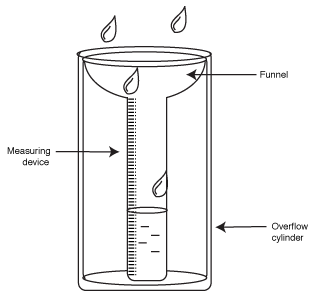Specialist Tips for Making Use Of a Rain Gauge to Monitor Citizen Weather Issues
Specialist Tips for Making Use Of a Rain Gauge to Monitor Citizen Weather Issues
Blog Article
Introducing the Science Behind Rainfall Gauges: Exactly How These Instruments Play an Essential Function in Environment Research and Environmental Surveillance
Rain assesses, relatively basic gadgets, hold an extensive relevance in the world of climate research study and ecological tracking. As we peel back the layers of this scientific veil surrounding rain determines, we reveal a globe where accuracy, data accuracy, and meticulous monitoring merge to reveal a deeper understanding of our changing climate and its influence on the world.
Value of Rain Gauges
Rainfall assesses play a crucial duty in tracking and gauging precipitation levels, giving essential information for climate research and evaluation. These gadgets are fundamental in evaluating the quantity of rainfall that takes place in a certain area over a particular period. By collecting and gauging rain, rain assesses offer valuable understandings into the circulation and intensity of precipitation, assisting meteorologists, hydrologists, and climatologists in comprehending weather condition patterns and patterns.
In addition, long-term data collected from rain assesses assists in assessing environment change impacts and patterns, contributing substantially to scientific research study and decision-making procedures. In significance, rain assesses offer as crucial devices in the field of meteorology and environmental science, playing a crucial role in advancing our understanding of weather condition and climate characteristics.
Kinds of Rainfall Gauges

Capability and Procedure
In the world of climate research and meteorological studies, the effectiveness of rain gauges lies in their intricate functionality and specific functional systems. Rain gauges are designed to properly gauge the quantity of precipitation that tips over a specific location during a set duration. These gadgets normally contain a funnel that accumulates rain and channels it right into a gauging tube. The determining tube is marked with calibrated dimensions that permit the precise metrology of rainfall.
The functionality of rainfall evaluates is based on the concept of determining and gathering rain in a standardized fashion. This accumulated data is crucial for recognizing local weather condition patterns, tracking long-term climate fads, and evaluating ecological impacts. To make sure exact measurements, rainfall gauges demand to be strategically positioned in open areas far from blockages such as buildings or trees that can disrupt the collection process.
The functional aspect of rainfall gauges entails regular upkeep to avoid debris buildup, calibration checks to maintain dimension accuracy, and information taping for analysis (rain gauge). Overall, the capability and operation of rainfall evaluates are important for collecting reputable rainfall information important to environment research and environmental monitoring
Function in Environment Research
Given the important importance of accurate precipitation measurements in understanding weather patterns and environmental impacts, the role of rain evaluates in climate research is essential. Rain gauges provide essential information for environment research study by measuring the amount of precipitation that drops over a particular area throughout a provided duration. This information is essential for monitoring lasting fads in rainfall patterns, evaluating the impact of environment adjustment on rainfall distribution, and boosting environment models.

Environment scientists utilize information collected from rainfall assesses to analyze variations in rainfall levels, determine regional environment patterns, and examine the efficiency of water resource management strategies. By comparing historic rainfall information with present dimensions, researchers can find changes in rainfall patterns, such as adjustments in the frequency or strength of rains events. This details is vital for recognizing exactly how environment change is affecting rainfall dynamics and can aid policymakers make notified choices concerning adjustment and mitigation approaches.
Applications in Environmental Monitoring

In flooding forecasting, rain scale data helps to track rains strength and distribution, allowing authorities to issue prompt cautions and take needed actions to reduce flood risks (rain gauge). Dry spell tracking depends on rain scale data to evaluate moisture degrees in the soil and track precipitation deficiencies, helping in the identification of drought-prone areas and the execution of drought response strategies
In addition, rain gauge information Going Here plays a vital function in water source monitoring by offering info on water availability and usage patterns. In addition, in farming, rainfall scale information assists farmers in enhancing watering schedules, crop option, and overall farm administration methods based on neighborhood precipitation patterns.
Conclusion
In conclusion, rain evaluates are necessary devices for gauging rainfall, supplying useful information for look at this site environment research study and ecological tracking. With different types and performances, rain assesses play a critical duty in recognizing rainfall patterns and their influence on the setting. By properly gauging rains, these tools add to the advancement of scientific understanding and assistance in making notified decisions related to water resource monitoring and calamity readiness.
Rain gauges play an important function in monitoring and gauging rainfall levels, providing essential information for climate research and evaluation. The common rain gauge, recognized as the "tipping container" gauge, is one of the most generally utilized devices. Ultrasonic rainfall evaluates usage noise waves to discover the presence of rainfall, supplying real-time data on precipitation degrees.Environment researchers utilize information accumulated from rainfall evaluates to analyze here are the findings variations in precipitation degrees, identify local environment patterns, and evaluate the performance of water resource administration strategies.In verdict, rain assesses are vital devices for determining rainfall, providing useful data for environment study and ecological surveillance.
Report this page